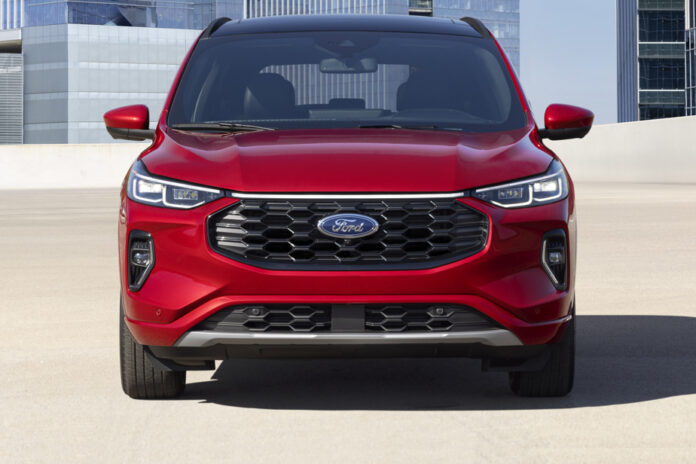Ford regulars will have noticed that this Escape appears in a more modern and assertive design for 2023. Most of the work was done on the facade. The grille is a little less visually striking and is topped with a Volkswagen-style light bar. The headlights are also more tapered and are placed below the hood line. Without being very daring, it gives it a new lease of life. Despite its name which suggests a certain sportiness, the ST-Line livery tested is basically just an aesthetic group adding certain charcoal bodywork elements married to a – false – protection plate imitating polished aluminum. The hybrid variant is discreetly labeled on the tailgate by means of a tiny badge.
The interior of this Escape is sober and overall well presented. We appreciate the positioning of the new optional 13.2-inch multimedia screen, just high enough for readability, without affecting visibility too much. Depending on the choice you make, you have physical keys or a smooth strip of keys activating digital menus. The low dashboard modeled around soft materials is well designed. The red stitching depicting diamond and hexagonal patterns on the leather upholstery adds a little luxury to the look. It’s a shame, however, that these seats, with their short seat, their basic lateral support and their firm padding, do not give the impression of high quality. The interior volume is generous both for passengers and for the 974 L cargo space accessible via a wide tailgate opening.
Two turbocharged four-cylinder engines and two hybrid engines, one conventional and the other plug-in, make up the proposal. The example tested is powered by a 2.5L four-cylinder engine supported by an electric motor for 192 hp in total. Its CVT gearbox can transmit torque to all four wheels, an option while the standard livery is front-wheel drive. Ensuring remarkable efficiency of 5.4 L/100 km over nearly 500 km during the test period, it is also distinguished by its great discretion ensured by a homogeneous dialogue between the two engines. Its torque also gives it confidence in urban driving, but it cannot be characterized as fiery in any way, given that it has to move nearly 1700 kg. An “EV Coach” function helps guide the driver to optimize their driving in order to save fuel.
In this arena heavily populated with compact SUVs, the Escape stands out through the performance of its chassis. Very predictable and balanced, it contains the roll with confidence and its steering, just firm enough, is surprisingly effective, although it does not always offer a uniform feel when cornering. It is therefore difficult to always be sure of the behavior of the front axle, a weakness which is however less marked than with its rivals. Comfort is also very adequate, as is soundproofing, making it comfortable in multiple contexts. The only downside is the braking, which remains a little temperamental. At the end of the pedal stroke, it becomes clearly too sensitive, forcing continual adjustment when traveling at low speed.
Far from the first iteration of this system which must still give its owners hives as it was so unstable, the SYNC 4 is a model of intuitiveness. Its new horizontal touch screen complements it well with the configurable digital instrumentation, equipment which has become very common. The tabs are clear and well laid out and the positioning of the heating and cooling menu at the bottom at all times, even when CarPlay or Android Auto is on, is well thought out. That said, nothing replaces the good old rotary dials, still present in less opulent liveries. Finally, let us note a construction of options that is not really competitive. Adaptive cruise control is not included as standard, nor are heated seats or all-wheel drive.
So, this hybrid Escape still has its reason for existence at a time when the electric offer is becoming greater and greater? Yes, but always as a transitional technology. The frugality of its mechanics and its user-friendliness make it a product that deserves more attention in the face of Japanese and South Korean rivals. No doubt too busy promoting its F-150, Ford would benefit from paying more attention to it. Its version structure, however, makes it a contender that is not always competitive, as evidenced by the $53,379 required to purchase the example tested. Despite its very extensive equipment, it is obviously much too expensive for a livery that is not pluggable. The Escape would benefit from a standard hybrid offering, an element that would set it apart and highlight this excellent mechanics. In the meantime, if the appeal of the options isn’t too great for you, this hybrid SUV is certainly interesting, but not class-leading.
With an estimated average of 6 L/100 km, this Escape Hybrid ties the RAV4 Hybrid’s average at the top of the list of most fuel-efficient hybrid compact SUVs. Note that the all-wheel drive version consumes no more than the front-wheel drive variant.
Offered only in the ST-Line version, the two-wheel drive hybrid powertrain increases the starting bill to $43,044 for 2024 when taking into account related costs. That’s $5,300 more than a Toyota RAV4 Hybrid (2023) equipped with standard all-wheel drive.
A plug-in hybrid version is offered as an option for the Espace with the same hybrid group, but a little more powerful (210 hp) and only front-wheel drive. Its range is estimated at 60 km in exchange for an entry price of $49,194, excluding incentives of $7500.
To slightly increase cargo space when children are seated in the rear seat, the Escape allows us to move it forward using adjustment rails.
If you want to tow with your Escape, the 2L turbocharged version (250 hp) increases the towing capacity to 1588 kg (3500 lb), which can make it very attractive. The hybrid version makes do with 680 kg (1500 lb).















